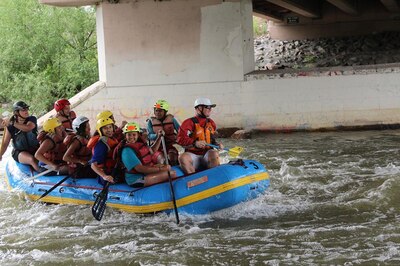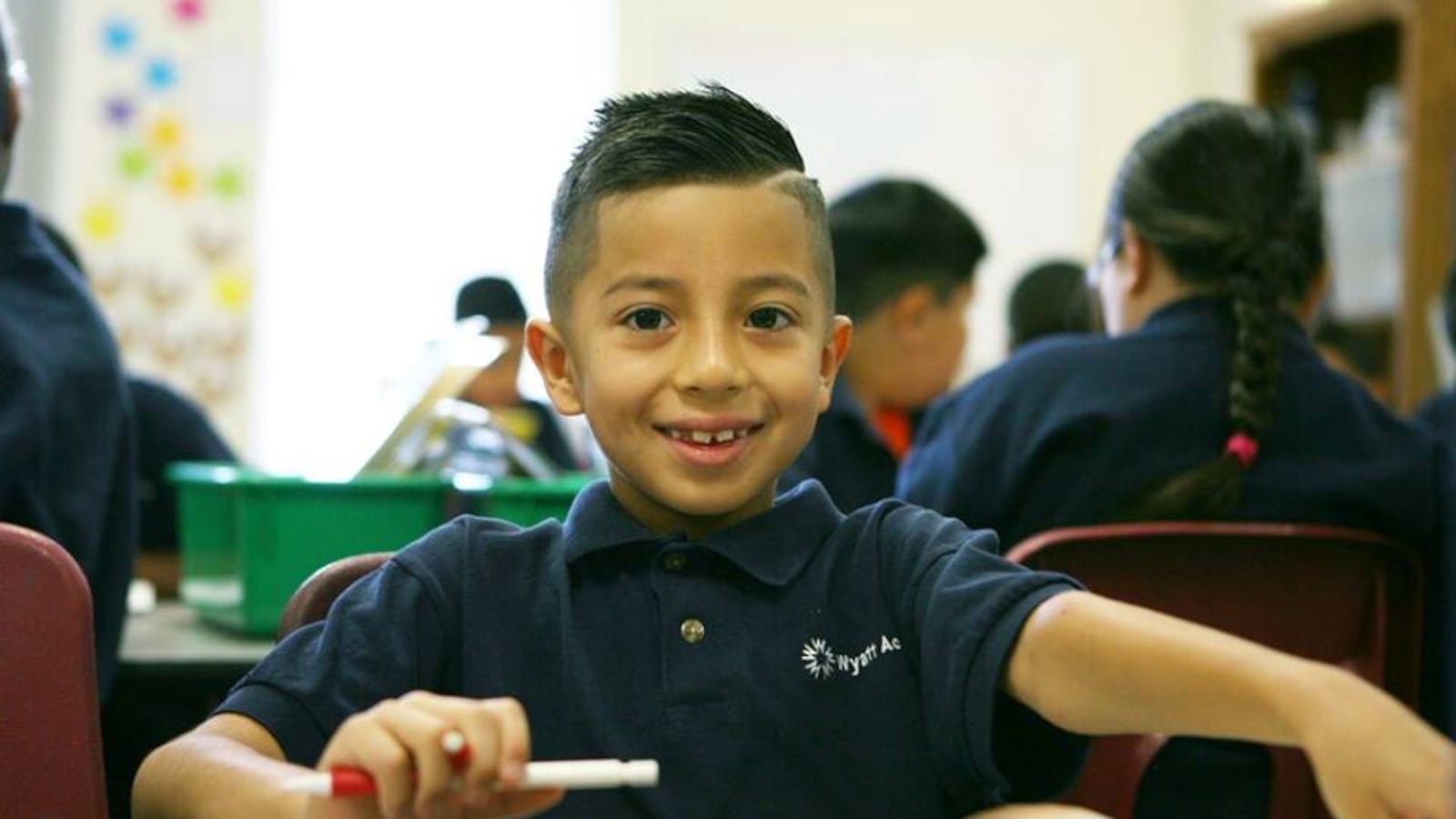When the Wyatt-Edison charter school opened in 1998 in one of Denver’s poorest neighborhoods, optimism abounded.
It was a new school breathing new life into a historic northeast Denver building that had long been abandoned to gang graffiti and pigeons. It was also a new kind of school: The for-profit Wyatt-Edison promised better results for students while making money for shareholders.
The latter never happened. But for a while, students exceeded expectations. In 2004, the charter school won a $10,000 prize from the federal education department for increasing state test scores for low-income students over a period of several years.
By last year, however, a combination of factors had caused Wyatt’s scores to plummet to among the lowest in Denver Public Schools. District officials were considering closing the school, now known as Wyatt Academy. Teachers, parents and students asked for one more chance.
With some trepidation, the school board agreed.
Wyatt is now beginning its last-chance year, with a new principal at the helm and a plan to improve learning through more coaching for teachers and better curriculum for students.
But turning around a school with such low test scores is notoriously hard — and the bar DPS is asking Wyatt to meet is high, especially given that the school will be judged primarily on test scores from last year, before its aggressive improvement plan was in place.
That hasn’t stopped new principal Wesley Frakes from being optimistic. “I certainly have no illusions of coming in and saving anybody,” he said. “This community has been rigorous and full of pride and full of energy before I was here — and now my job is to just unleash it.”
• • •
The idea to turn a boarded-up relic into a modern-day school came from the neighborhood.
Local activists, benefactors and politicians had been trying for years to clean up the old Wyatt School, an imposing building with a turret over the entrance and a grand staircase in the center. It was designed by Colorado’s first registered architect and opened in the late 1880s.
But a shrinking student population in northeast Denver caused DPS to shutter the school in 1982, according to news reports. The kids who’d attended Wyatt were sent to other schools.

Wyatt was left to decay. A 1991 Rocky Mountain News story described the inside:
“Today, the staircase and hallways are littered with dead pigeons, hunks of asbestos-tainted ceiling, broken glass and charred remnants of intentionally ignited papers and trash. Kids can slip into the dark, cavernous interior through an unsealed basement casing. The inside is dangerous, with ample opportunities to fall from high perches above the three-story-high lobby.”
Plans to transform the building into something useful came and went. Then, in 1995, a company called the Edison Project began courting school districts in Colorado. The state had passed a law two years earlier allowing the creation of charter schools, which are autonomous public schools funded by state dollars. Edison was interested.
The company was out to prove that a for-profit business could educate American children better and for less money than the government. It was the brainchild of entrepreneur Chris Whittle, who’d previously started a commercial classroom television network called Channel One.
The Edison model called for longer school days and an extended school year, an emphasis on reading and a home computer for every student. The company planned to operate a chain of schools across the country using only the per-pupil dollars available to all public schools and to profit from the efficiencies of doing business on such a large scale.
In 1996, Edison applied to open a charter school in Denver. Known today as one of the most charter-friendly districts in the country, it only had two at the time. A group of northeast Denver community members saw an opportunity in Edison’s proposal for the neighborhood’s children — and for the festering Wyatt School building — and agreed to partner with the company.
The Denver school board gave Edison the go-ahead, impressed by its community support, focus on technology and willingness to educate low-income children of color who had historically scored poorly on tests, according to news reports.
“They asked for the most difficult assignment,” one board member remarked.
It took longer than expected to raise the $6 million needed to renovate the old building. But thanks to big investments from local foundations and businessmen, Wyatt-Edison charter school opened with about 650 students in kindergarten through sixth grade in the fall of 1998.
“It was going to be a great anchor in the community,” said Mary Cronin, the former president and executive director of the Denver-based Piton Foundation, which contributed half a million dollars to the Wyatt renovation. “In the beginning, everything went well.”
• • •
That’s not to say there weren’t challenges.
Many of the students that first year had significant behavior issues — and by the spring, 40 students had been pulled out by their parents because their classmates were too disruptive, according to the Rocky Mountain News.
Several teachers had also left — or just never shown up at all. The home computers families were supposed to receive didn’t materialize until the following year.
"They asked for the most difficult assignment."
former DPS school board member
And perhaps unsurprisingly, students’ initial test scores were low. Only 21 percent of students scored at the proficient level or above on state reading tests, according to news reports.
But over the next few years, test scores steadily improved. For instance, the percentage of Wyatt-Edison sixth graders who scored proficient or above in reading doubled between 2001 and 2003, from 22 percent to 44 percent.
“I’ve been so happy,” a student named Jesualdo Jara told the Denver Post in 2004. “The teachers, they have communicated with us. When we need help, they stay until 5 o’clock.”
Many families saw the school as the best option in the neighborhood. A 2004 Rocky Mountain News story points out that Wyatt-Edison, which by then had expanded to serve seventh and eighth graders, outscored nearby Cole Middle School by an average of 26 percentage points on state middle school tests — even though the two schools served similar students.
Then-principal Kay Frunzi credited Wyatt’s success to the flexibilities afforded the school because it was a charter, including the ability to more easily fire ineffective teachers and to creatively use her budget to hire enough staff to allow teachers 45 minutes of planning time and 45 minutes to meet with one another and receive additional training each day.
While those strategies may seem commonplace in charter schools today, they were still somewhat revolutionary a decade ago. In fact, many tenets of Edison schools — such as adopting a mission statement, frequently testing students to see if they understand the material and paying teachers based on performance — were ahead of their time.
In 2008, DPS began rating schools on a color-coded scale that took into account test scores, demand, and student and parent satisfaction. The highest color on the scale — blue — means a school is rated “distinguished.” The next-highest rating is green. Then yellow, orange and red.
Wyatt-Edison was green in 2008, 2009 and 2010. But by 2011, turmoil at Edison and leadership turnover at Wyatt had caught up to the school — and it slipped to yellow. In 2012, it was orange. And in 2013, it sunk to red. While parents still reported being satisfied, test scores plummeted, dragging down the school’s rating — and putting its charter in danger.
• • •
By then, the original idea behind the Edison Project, later known as Edison Schools, had essentially crashed and burned.
The company’s decline was years in the making. In 2002, Fortune magazine reported Edison stock was trading at less than $2, down from a high point of nearly $37. The company was suffering record losses and had millions in debt.
The magazine concluded that Whittle, Edison’s founder, had “miscalculated how tricky and expensive it was to run a school.” At that point, Edison had 150 of them across the country, though that number was declining as more and more districts canceled their contracts.
In 2003, Edison was bought by an investment firm. In the years that followed, the company, now known as EdisonLearning, shifted focus, according to news accounts and Wyatt staff.
Though it is still involved with some urban charter schools, including the Omar D. Blair Charter School in far northeast Denver, the company began concentrating more on products such as online curriculum. Since 2013, Colorado law has required charter schools to be non-profit, although they can contract with for-profit companies to provide services.
Joe Taylor, a longtime and much-loved Wyatt teacher who served as principal for the past two school years, said resources and oversight from Edison diminished over time.

The company used to host a two-week summer session for teachers from across the country to learn about Edison curriculum and school culture — what Taylor jokingly called “indoctrination in the Edison way” — in addition to ongoing training throughout the school year. The company also provided the school leaders, recruiting motivated principals from all over the nation.
But eventually, Taylor said, the teacher training sessions went from in-person assemblies to PowerPoint presentations sent over email. As support from Edison decreased, principal turnover increased; in one five-year period, Wyatt had six different leaders, Taylor said.
“Without investment and engagement and people, it’s like a church without a preacher,” he said.
Wyatt’s board of directors watched as student achievement suffered. “We debated a long time as a board: What were we going to do?” said Cronin, who served for a total of 12 years.
In the end, the board decided to sever its relationship with Edison. It was a move that promised to free the school from an increasingly unhelpful management company, but it came with its own hurdles. The board was all of a sudden responsible for the myriad duties Edison once handled, including choosing principals, picking curriculum and training teachers.
“That was the hesitation in taking that leap,” said board member Emily Bustos, who joined shortly before the vote. “We knew it was going to be a lot of work.”
The uncoupling was complete in 2013-14 — and Wyatt began its first year as an independent charter known as Wyatt Academy. Halfway through the year, the principal announced his intention to leave. The board appointed Taylor to take over starting the summer of 2014.
A few weeks into the job, he was called into a meeting with DPS bigwigs. State test scores had just been released — and district officials, who had blessed Wyatt’s independence, were concerned with what they saw as a trend of poor performance.
“They said, ‘We have to let you know we’re considering revocation of your charter,’” Taylor recalled. Wyatt’s charter was technically still valid; DPS had signed a five-year contract with the school in 2011 that was scheduled to run through June 2016.
But given that just 35 percent of students had scored proficient or above in reading on state tests, and only 37 percent of students had scored that way in math, the district was considering pulling the plug on the school a year early. Because of the low scores, Wyatt would be “red” on DPS’s color-coded rating system for the second year in a row.
But to Taylor, the school was more than test scores. It was a community hub.
Most students come from the neighborhood. That’s despite the fact that Wyatt was an open enrollment school with no boundaries until this year, when its middle school was included in a DPS “enrollment zone” with several other area middle schools, meaning that neighborhood kids are guaranteed a spot at one of those schools.
Nearly all of Wyatt’s students in kindergarten through eighth grade — about 99 percent — are children of color. About half are English language learners. And 95 percent qualify for government-subsidized lunches.
To serve all of their needs, Wyatt partners with a variety of community organizations, including after-school programs, gang prevention initiatives and a nonprofit that takes inner-city kids white water rafting and rock climbing. The school last year hosted monthly parent advisory council meetings and weekly healthy cooking classes for families.
To stave off revocation, Taylor negotiated a deal with DPS: If Wyatt didn’t hit certain academic goals during the 2014-15 school year, it wouldn’t apply for a charter renewal the following year. In other words, if Wyatt didn’t perform, it would close up shop.
That year, the state switched to a new set of standardized reading and math tests called PARCC. Because the tests were new, it took the state longer to calculate students’ scores. That meant that when it was time last fall to apply for renewal, Wyatt still didn’t know whether its third- through eighth-graders who took PARCC met the agreed-upon benchmarks.
But it did have scores from a different set of tests taken by its kindergarten, first and second grade students — and the results were positive. They showed that most kids who were behind in reading had made significant progress, as had young English language learners.
Another set of tests given solely to English language learners in all grades showed that more of them were on track in acquiring the language that year than the year before.
So Wyatt decided to ask DPS for another chance.
• • •
On a November evening, dozens of Wyatt parents, students, teachers and staff packed the school gymnasium where the Denver school board holds its monthly meetings. They wore blue T-shirts printed with the slogan, “We are Wyatt.” Some of them addressed the board.
Eighth-grader Iyauna Anderson told the board that before going to Wyatt, she didn’t like reading or math. She said she’d grown into an honor student who was already earning high school credit and had gone on field trips to Keystone and to see a Shakespeare play.
“This school has become a home to me,” she said.
Parent Rodney Bates, whose older children attended Wyatt the year it opened and whose eighth-grade daughter started there as a kindergartener, said the school encourages kids to dream big and inspires them to become doctors, lawyers and CEOs.
“By closing Wyatt, you’re not supporting Wyatt or these students,” said Bates, who serves on Wyatt’s board.
By then, the state had calculated Wyatt’s PARCC scores. Since the tests were new and the district couldn’t look at Wyatt’s performance year over year to see if the school was improving, it compared Wyatt’s scores to the scores of schools with similar numbers of at-risk kids.
Wyatt students did worse than those students on the new, more difficult tests: Just 17 percent of met expectations in reading and only 11 percent did so in math.
District officials also visited Wyatt to figure out if the school was on the right track, despite its low test scores. The visits turned up a number of bright spots but also some trouble areas.
“The level of instruction observed … was often significantly below grade-level,” the subsequent report said, “and teacher attention in many classrooms focused on redirections and behavior issues rather than engaging students in grade-appropriate academic content and tasks.”
In the end, however, district staff recommended the board renew Wyatt’s contract for the 2016-17 school year — the shortest contract length possible.
Maya Lagana, the director of quality assurance and accountability for DPS’s portfolio management team, which oversees charter schools, said DPS was hesitant to condemn the school based on a single year of PARCC data. Plus, she said, some of its test scores were promising, especially the reading progress made by its youngest students.
At the time, the district was also in the process of coming up with criteria for when to close chronically low-performing schools. Lagana said it made sense to wait for the new policy to kick in this fall and to judge Wyatt by the same criteria that would be used to make closure decisions about all district schools, including charter schools.

With some apprehension, the board agreed in December to give Wyatt another shot. Board members said they were impressed by school leaders’ willingness to acknowledge the school’s shortcomings. In addressing the board at that meeting, principal Taylor thanked DPS officials for their honest criticism and said it helped his thinking about how to improve.
“It’s a big hill to climb, but the Wyatt community continues to embrace the challenge,” he said.
Board member Happy Haynes said that attitude made all the difference. “We so often hear with schools that are struggling, ‘Don’t close this school! Everything is wonderful!’” she said. “I am persuaded by the fact that you’ve been making decisions with your eyes open and with a recognition of the challenges that you’ve had. To me, that’s the first step to getting better.
“I encourage you to stay focused,” Haynes added. “I don’t want to be here a year from now.”
• • •
The kindergarteners sat on the colorful rug, clad in matching Wyatt Academy shirts, their eyes on the teacher and their fingers pinched together as if they were holding invisible pencils. The teacher was singing a song to the tune of, “If you’re happy and you know it.”
“Where do we start our letters? At the top, top, top,” she sang.
The children held their imaginary pencils high in the air and practiced writing letters.
“Little curve, little curve, bump,” the teacher instructed, demonstrating a lowercase “s.”
"I am interested in having a group of kids show the community that they’re more than their ZIP code."
Wesley Frakes, principal
Upstairs, eighth-graders kneeled on the blue-and-white tile floor, conducting a science experiment to demonstrate the concept of force. A group of rambunctious boys set up a plastic train track, their boisterous energy turning into furrowed-brow concentration.
The point of the experiment was to measure how far a plastic train car, released from the top of an incline, could push a block of wood down the track. When one boy placed the wood block at the wrong starting point, another gently corrected him in middle school parlance.
“Nah, bro,” he said. “You have to start it from the 5 centimeters.”
It was several weeks after the school board vote, and while Wyatt’s more than 500 students were in class, school leaders were busy coming up with a plan to drastically improve learning.
One of the biggest components? Taylor decided to step down as principal at the end of the year and help recruit a leader with experience turning around a low-performing school — a move district staff heralded as both brave and selfless.
“I dont have the unique training, background and skill set that meets the profile of a successful turnaround leader,” said Taylor, who began his career as a special education teacher. “There is so much … research that suggests that’s where turnaround starts.”
Over the next several months, Wyatt hired consultants to coach teachers who needed extra help and started using a more rigorous screening process for hiring new employees.
And by the spring, it had hired Frakes to take over as school leader. A former teacher, he’d recently served as principal of a California charter he said fought to open in a school shuttered by the district. By the time he left, Frakes said, the charter was one of the highest performing secondary schools in the county. He moved to Denver and took a job last year as the leader of the high-scoring Odyssey charter school but resigned before the year ended, according to minutes from a meeting of the school’s board of directors.
Frakes said Wyatt was a better fit for him. When he first visited, it felt like home.
“I am interested in having a group of kids show the community that they’re more than their ZIP code,” said Frakes, who explained that he himself grew up in poverty. “I have the life I have now because of serendipity. These kids are beautiful and brilliant.”
This past summer, Frakes worked to overhaul Wyatt’s curriculum and revamp its system for evaluating teachers and providing them with ongoing coaching throughout the year. He also reduced the front office staff to put more resources in the classrooms and let several teachers go; about 50 percent of teachers at Wyatt this year are new to the school.
“It’s not a yes to employment,” Frakes said. “It’s a yes to a mission.”
Later this month, DPS schools are expected to find out where they fall on the district’s color-coded rating system. State test scores are a big part of the ratings — and results released last week show Wyatt made some gains. For instance, 24 percent of Wyatt fourth-graders met or exceeded state expectations in English last spring — which is lower than the district average of 37 percent but higher than the 10 percent of Wyatt fourth-graders who met that bar in 2015.
However, an even bigger factor in DPS’s rating system is still unknown. The state has yet to release so-called academic growth numbers that show whether the fourth-graders who took the tests in 2015 did better when they took the tests as fifth-graders in 2016 — a measure DPS considers better for judging whether students are learning.
"I am functioning as if we are full-on in year one of turnaround."
Wesley Frakes, principal
Once that data is released and schools, including Wyatt, are given a color rating, the district has said it plans to rank all of its schools from highest to lowest using three years’ worth of ratings, as per its new school closure policy. Schools in the bottom 5 percent will be flagged.
If those schools showed adequate academic growth on the most recent state tests, they’ll be safe from closure. If they didn’t, they’ll each get an in-depth evaluation similar to the one Wyatt underwent last year. Those evaluations will likely happen in October, according to DPS.
If a school’s evaluation indicates the school is on a path to improvement, it will be safe. If the evaluation indicates the opposite, the school could be closed. The DPS school board is expected to make those decisions in November or December. That’s also when the board will have to decide whether to renew Wyatt’s charter for another year or longer.
Some schools will be exempt from the policy. The district has said it will give special consideration to struggling schools that are in the midst of trying to improve through drastic measures, such as replacing the principal and at least half the staff.
But Wyatt won’t be among them. According to Lagana, it doesn’t qualify as an official “turnaround” school because its strategies weren’t yet in place when the school board adopted the school closure policy in December, among other reasons.
Wyatt leaders don’t think that distinction is fair. “I am functioning as if we are full-on in year one of turnaround,” Frakes said. If the school board decides not to renew Wyatt’s charter, Frakes said Wyatt is prepared to exercise its right to appeal that decision to the State Board of Education, which has a reputation for siding with charter schools.
“We have literally already moved the needle,” Frakes said of progress made this school year. “Give me a year, give me two years and we’ll move mountains.”

